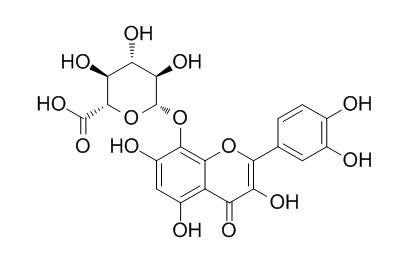Hibifolin
Hibifolin can act as a potential inhibitor of ADA, it protects neurons against A beta-induced apoptosis and stimulates Akt activation, which would be useful in developing potential drugs or food supplements for treating AD. Hibifolin behaves as a dual inhibitor of PGE2 and leukotriene B4 (LTB4) formation in peritoneal exudates, thus it shows anti-inflammatory activity.
Inquire / Order:
manager@chemfaces.com
Technical Inquiries:
service@chemfaces.com
Tel:
+86-27-84237783
Fax:
+86-27-84254680
Address:
1 Building, No. 83, CheCheng Rd., Wuhan Economic and Technological Development Zone, Wuhan, Hubei 430056, PRC
Providing storage is as stated on the product vial and the vial is kept tightly sealed, the product can be stored for up to
24 months(2-8C).
Wherever possible, you should prepare and use solutions on the same day. However, if you need to make up stock solutions in advance, we recommend that you store the solution as aliquots in tightly sealed vials at -20C. Generally, these will be useable for up to two weeks. Before use, and prior to opening the vial we recommend that you allow your product to equilibrate to room temperature for at least 1 hour.
Need more advice on solubility, usage and handling? Please email to: service@chemfaces.com
The packaging of the product may have turned upside down during transportation, resulting in the natural compounds adhering to the neck or cap of the vial. take the vial out of its packaging and gently shake to let the compounds fall to the bottom of the vial. for liquid products, centrifuge at 200-500 RPM to gather the liquid at the bottom of the vial. try to avoid loss or contamination during handling.
Phytomedicine.2022, 99:154025.
J Biol Chem.2014, 289(3):1723-31
Molecules.2023, 28(5):2376.
Front Aging Neurosci.2018, 10:269
BMC Complement Altern Med.2017, 17(1):393
Int J Mol Sci.2019, 20(21):E5488
Food and Chemical Toxicology2020, 111221
Food Sci Biotechnol.2023, 32(7):997-1003.
Anal Bioanal Chem. 2016, 408(15)
Nat Commun.2021, 12(1):681.
Related and Featured Products
Neuroscience Letters, 2009, 461(2):172-176.
Hibifolin, a flavonol glycoside, prevents β-amyloid-induced neurotoxicity in cultured cortical neurons.[Reference:
WebLink]
The toxicity of aggregated beta-amyloid (A beta) has been implicated as a critical cause in the development of Alzheimer's disease (AD). Hibifolin, a flavonol glycoside derived from herbal plants, possessed a strong protective activity against cell death induced by aggregated A beta.
METHODS AND RESULTS:
Application of Hibifolin in primary cortical neurons prevented the A beta-induced cell death in a dose-dependent manner. In cultured cortical neurons, the pre-treatment of Hibifolin abolished A beta-induced Ca(2+) mobilization, and also reduced A beta-induced caspase-3 and caspase-7 activation. Moreover, DNA fragmentation induced by A beta could be suppressed by Hibifolin. In addition to such protection mechanisms, Hibifolin was able to induce Akt phosphorylation in cortical neurons, which could be another explanation for the neuroprotection activity.
CONCLUSIONS:
These results therefore provided the first evidence that Hibifolin protected neurons against A beta-induced apoptosis and stimulated Akt activation, which would be useful in developing potential drugs or food supplements for treating AD.
Computational biology & chemistry, 2016, 64:353-358.
Inhibitory activity of hibifolin on adenosine deaminase- experimental and molecular modeling study.[Reference:
WebLink]
Adenosine deaminase (ADA) is an enzyme involved in purine metabolism. ADA converts adenosine to inosine and liberates ammonia. Because of their critical role in the differentiation and maturation of cells, the regulation of ADA activity is considered as a potential therapeutic approach to prevent malignant and inflammatory disorders.
METHODS AND RESULTS:
In the present study, the inhibitory activity of a plant flavonoid, Hibifolin on ADA is investigated using enzyme kinetic assay and isothermal titration calorimetry. The inhibitory constant of Hibifolin was found to be 49.92μM±3.98 and the mode of binding was reversible. Isothermal titration calorimetry showed that the compound binds ADA with binding energy of -7.21Kcal/mol.
The in silico modeling and docking studies showed that the bound ligand is stabilized by hydrogen bonds with active site residues of the enzyme.
CONCLUSIONS:
The study reveals that Hibifolin can act as a potential inhibitor of ADA.
Agents & Actions, 1991, 32(3-4):283-288.
Anti-inflammatory activity and inhibition of arachidonic acid metabolism by flavonoids.[Reference:
WebLink]
A group of flavonoids isolated from medicinal plants and which are selective inhibitors of lipoxygenase activity in vitro: sideritoflavone, cirsiliol, hypolaetin-8-O-beta-D-glucoside, hypolaetin, oroxindin, quercetagetin-7-O-beta-D-glucoside, gossypin, Hibifolin and gossypetin, besides leucocyanidol, have been studied for their effects on acute responses induced by carrageenin in mice.
METHODS AND RESULTS:
The oral administration of flavonoids to mice inhibited dose-dependently the development of paw oedema at 1, 3 and 5 h after carrageenin injection. A similar administration of flavonoids induced a dose-dependent inhibition of leukocyte accumulation in inflammatory exudates following intraperitoneal injection of carrageenin into mice. Some of the flavonoids exhibited a potency against leukocyte infiltration similar to that seen for inhibition of carrageenin oedema at 3 h of induction. In agreement with data reported in rats, indomethacin was much more effective on inhibition of prostaglandin E2 (PGE2) formation than on leukocyte infiltration in mice.
The selectivity of flavonoids towards lipoxygenase is not retained in vivo since they behave as dual inhibitors of PGE2 and leukotriene B4 (LTB4) formation in peritoneal exudates.
CONCLUSIONS:
Our data support the inhibition of arachidonic acid metabolism as one of the mechanisms by which flavonoids exert their anti-inflammatory effects.



